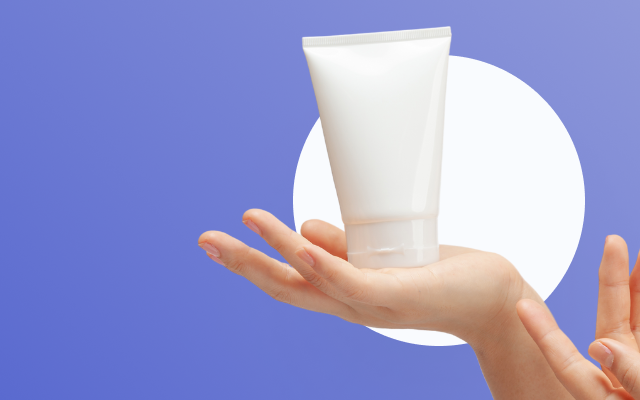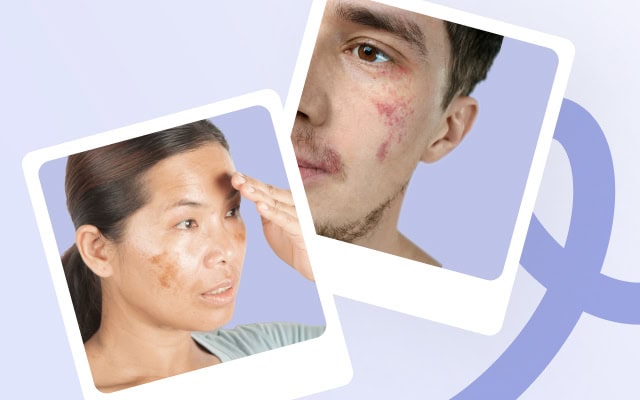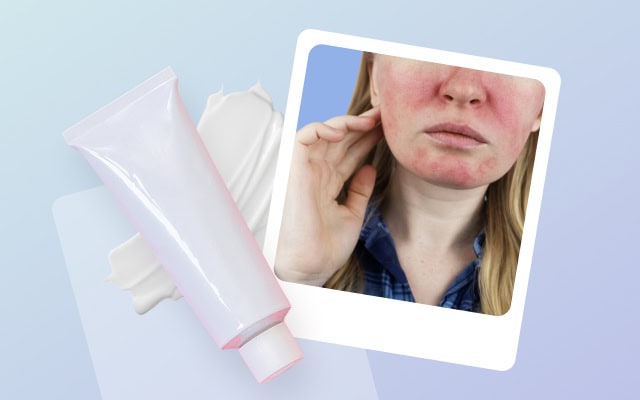Nummular eczema vs ringworm: What is the right treatment for each?
Dr. Patrick Mahar, Associate dermatology professor, explains the difference and similarities between ringworm and nummular eczema and tells you get online treatment for both conditions.
Table of Content:
Similarities | Differences | What is eczema? | Causes | Symptoms | Treatment | What is ringworm? | Causes | Symptoms | Treatment | Conditions that resemble ringworm and eczema
Our commitment to producing high-quality content:
The information presented in this article is based on scientific research and the professional advice of our Content Medical Reviewers, who are experts in the field of Dermatology. How we write our content →
Dr. Patrick Mahar, dermatologist explained that ringworm and a type of eczema (called nummular eczema, dermatitis, discoid eczema, discoid dermatitis) are two skin conditions that are commonly confused by patients since both have a coin-shaped appearance and they both have similar symptoms.
However, eczema and ringworm have very different causes (since the first one is a type of skin inflammation and the second one is caused by a fungus) and are treated very differently.
Author’s Note: For the purposes of this article, please consider the words nummular and discoid to be interchangeable, as with the terms eczema and dermatitis.
Similarities between ringworm and nummular eczema
- Both nummular eczema and ringworm can form round or oval-shaped lesions on the skin
- They can both cause redness in the affected areas
- They can both cause itching
- They can both cause scaling or flaking around the affected areas
- Scratching in both conditions can cause secondary bacterial infections
Differences between nummular eczema and ringworm
- Nummular eczema is a type of eczema (skin inflammation) while ringworm is caused by fungal infection (usually tinea)
- Ringworm is contagious and eczema is not
- Nummular eczema tends to appear primarily on the limbs, hands and feet, whereas ringworm can occur on various parts of the body, including the scalp, groin, and nails
- The treatment for eczema typically involves topical corticosteroids, while ringworm is treated with antifungal medications, either topically or orally, depending on the severity and location of the infection.
- One of the difficulties is that using topical corticosteroids on ringworm may help alleviate symptoms briefly, but just tends to perpetuate the problem.
Do I need a prescription for ringworm?
Not necessarily. You can try an over the counter anti-fungal cream first, but if it doesn’t work, you will probably then need a prescription as you may need a stronger medication or the skin rash is not caused by a fungal skin infection.
Do I need a prescription for nummular eczema?
Yes, if you have been diagnosed with nummular eczema or you think your skin problem is eczema, it is likely you will need prescription treatment to manage your symptoms.
How can I get a prescription for ringworm, eczema or another skin problem?
You can have a photo-consultation with a board-certified dermatologist who will evaluate your photos and clinical questionnaire for an appropriate diagnosis and treatment. You will get a prescription in 1-2 days.
Secure, confidential, and reviewed by board-certified dermatologists.
Are ringworm and nummular eczema contagious?
According to Dr. Mahar, ringworm is contagious since it is a fungal infection, while nummular eczema is not because it is a chronic condition.
What is nummular eczema?
Nummular eczema (often called discoid eczema or nummular dermatitis) is a chronic skin condition characterized by the presence of coin-shaped or oval-shaped skin lesions or patches on the skin. It causes itchy, round-shaped patches on the skin. This condition can be linked to other skin conditions like atopic dermatitis, asteatotic eczema, or stasis dermatitis. However, most people with this condition can be successfully treated with simple measures and topical corticosteroid creams1.
Causes of nummular eczema
The exact cause of eczema is unknown, however, it is believed that several factors may cause this condition
- Dry skin
- Allergies to certain substances
- Reactions to allergens in the air
- Staphylococcus bacteria on the skin
- Harsh soaps
- Frequent hot baths
- Low humidity in the environment
- Skin injuries
- Exposure to rough fabrics like wool
- Breast implants
- Some medications
- Chronic venous stasis (a condition affecting blood flow) could also increase the risk of developing this condition on the lower legs2.
Location of this type of nummular eczema
This type of eczema typically occurs on legs, forearms, or backs of the hands, and less commonly on the trunk3.
Symptoms of nummular eczema
- Inflamed coin-shaped spots
- Blister-like sores and bumps
- Spot color may vary from skin tone
- Very itchy
- Dry skin4
Nummular eczema treatment
To keep at bay the symptoms of nummular eczema, your dermatologist may recommend and prescribe the following:
- Lifestyle changes
- Avoidance of known triggers
- Stress management techniques
- Moisturizers
- Wet dressings
- Topical corticosteroids
- Topical calcineurin Inhibitors
- Oral antihistamines
- Phototherapy
- Certain oral medications
Secure, confidential, and reviewed by board-certified dermatologists.
What is ringworm (Tinea)?
Tinea corporis (commonly known as ringworm) is a skin rash caused by a fungal infection. Typically, it presents as an itchy, circular rash with a clearer center. The term “ringworm” describes its appearance, but it is important to note that no actual worm is responsible for the condition. Ringworm is closely related to athlete’s foot (tinea pedis), jock itch (tinea cruris), and ringworm of the scalp (tinea capitis). It usually spreads through direct skin-to-skin contact with an infected individual or animal5.
Causes of ringworm
Ringworm is a fungal infection caused by various dermatophyte fungi. It is contagious and can spread through direct contact with an infected person or contaminated objects like clothing and towels.
Location of ringworm
Ringworm can affect various parts of the body, including the feet (athlete’s foot), groin, inner thighs, or buttocks (jock itch), scalp, beard, hands, and even toenails or fingernails (onychomycosis). It can also appear on other areas like the arms or legs6.
Symptoms of ringworm
- Scaly, ring-shaped lesions often found on the buttocks, torso, arms, and legs
- Mild itching sensation
- A clear or scaly area inside the circular rash, sometimes accompanied by clusters of bumps, which can appear red on fair skin or exhibit shades of reddish, purplish, brown, or gray on darker skin tones
- Expanding rings that are slightly raised
- Circular, flat patches of itchy skin
- Instances of overlapping rings7
Ringworm treatment
- Clotrimazole
- Miconazole
- Griseofulvin
- Terbinafine
- Ketoconazole
- Itraconazole
- Fluconazole
- Good hygiene
- Avoid using harsh soaps or irritating products on the affected area8
Can eczema be mistaken for ringworm?
Yes, eczema can sometimes be mistaken for ringworm, and vice versa, because they can share certain similarities in their appearance, such as redness, itching, and the formation of round or oval-shaped lesions on the skin.
How can you tell the difference between nummular eczema and ringworm?
To accurately differentiate between nummular eczema and ringworm, it is advisable to consult a healthcare professional, such as a dermatologist. They can conduct a visual examination, possibly perform tests (such as skin scrapings or cultures), and provide a definitive diagnosis, leading to the appropriate treatment plan.
What other conditions may resemble ringworm and eczema?
Eczema, ringworm, and psoriasis
Psoriasis is a chronic skin condition (which means it is not contagious) that results in the development of scaly and inflamed patches of skin, commonly found on the scalp, elbows, or knees. However, it can also impact other areas of the body9. In some cases, psoriasis can present with coin-shaped lesions similar to eczema or ringworm. It can be challenging to make a distinction without clinical evaluation.
Pityriasis rosea vs ringworm
Pityriasis rosea is not contagious and often disappears by itself after 10 weeks. It usually starts with a single larger patch (herald patch) followed by smaller, scaly, oval-shaped lesions10. Pityriasis rosea (and especially the herald patch) can resemble the appearance of ringworm or nummular eczema and although it can happen at any age, it usually appears between the ages of 10 and 35.
Granuloma annulare vs ringworm
Granuloma annulare is an inflammatory skin condition that causes a raised rash or bumps in a ring pattern (similar to ringworm or eczema), although it does not tend to be scaly. Granuloma annulare is not contagious and usually not painful. It can be triggered by minor skin injuries or certain medications and it often affects young adults, usually on the hands and feet11.
Lichen planus vs ringworm
Lichen planus often appears as purple, itchy, flat bumps that develop over several weeks on skin, hair, nails, mouth and genitals. It is not contagious. In the mouth and genitals it forms lacy white patches, sometimes with painful sores. Mild lichen planus sores may not need treatment, however if the condition causes pain or intense itching, you may need prescription medicine12.
Erythema Annulare (EAC)
Erythema annulare centrifugum (EAC) is a non-contagious, skin condition characterized by circular, reddish lesions that start as raised, itchy bumps and expand outward. They often clear in the center, leaving a trailing scale at the advancing edge. EAC is considered a reaction of the skin and can be associated with various underlying health issues13.
Lee este artículo en Español ¿Tiña ó Eczema? Diferencias, causas y tratamiento
Key article points
- Symptoms: Flaky skin, redness, inflammation, greasy appearance, and sometimes ring-shaped rash.
- Triggers: Stress, weather changes, hormonal fluctuations, and exposure to harsh skincare products.
- Causes: Genetic predisposition and an inflammatory response to Malassezia yeast overgrowth.
- Management: Mild cleansers, moisturizing, sunscreen, gentle exfoliation, stress management, and a healthy diet.
- Treatment: Topical corticosteroids, coal tar, antifungal creams and shampoos, topical calcineurin inhibitors, and oral medications for severe cases.
Do you suspect you have seborrheic dermatitis? Consult an online dermatologist!
Article References:
https://www.niams.nih.gov/health-topics/psoriasis
https://www.mayoclinic.org/diseases-conditions/pityriasis-rosea/symptoms-causes/syc-20376405
https://www.mayoclinic.org/diseases-conditions/granuloma-annulare/symptoms-causes/syc-20351319
https://www.mayoclinic.org/diseases-conditions/lichen-planus/symptoms-causes/syc-20351378
https://www.ncbi.nlm.nih.gov/books/NBK482494/
https://www.ncbi.nlm.nih.gov/books/NBK565878/
https://www.aad.org/public/diseases/eczema/types/nummular-dermatitis/symptoms
https://www.ncbi.nlm.nih.gov/pmc/articles/PMC7375854/
https://www.cdc.gov/fungal/diseases/ringworm/definition.html
Skin conditions and treatments
Articles written in collaboration with dermatologists
Facial treatment for seborrheic dermatitis
How to get rid of rosacea permanently?
How to calm a rosacea flare-up fast?
Spongiotic dermatitis: What is it and what is the best treatment?
A dermatologist’s guide to psoriasis medication







 Still dealing with skin issues? Get expert help from home.
Still dealing with skin issues? Get expert help from home.